Physical Address
304 North Cardinal St.
Dorchester Center, MA 02124
Aging is a global phenomenon affecting the entirety of the face. Therefore, the gold standard for neck rejuvenation is formal facelift surgery with both direct and ancillary techniques that address the neck concurrently.
Improvement in neck contour is predicated upon skin release from retaining ligaments, appropriate alteration of the soft tissue in the intermediate or subplatysmal plane including subplatysmal fat, digastric muscles and submandibular glands when indicated, as well as appropriate skin redraping.
In select patients, the neck can be effectively treated in isolation through submental liposuction, an open submental-only approach (anterior lipectomy and platysmaplasty), or direct excision of neck skin with Z-plasty.
Minimally invasive injectables and energy-based modalities may result in moderate improvements in neck contour through skin tightening or fat reduction, but cannot replace formal surgical interventions.
Access video and video lecture content for this chapter online at Elsevier eBooks+ ![]()
![]()
Neck laxity is one of the earliest signs of facial aging and is, therefore, commonly present when patients present for facial rejuvenation. The gold standard for correcting the neck is through formal facelift surgery with a dedicated portion of the procedure focused on the cervical area ( ![]() ). Components of the facelift portion of the procedure also improves the aesthetics of the neck. This global approach to facial aging is the best option for most patients. However, under appropriate circumstances, as detailed in this chapter, the neck can be treated effectively in isolation.
). Components of the facelift portion of the procedure also improves the aesthetics of the neck. This global approach to facial aging is the best option for most patients. However, under appropriate circumstances, as detailed in this chapter, the neck can be treated effectively in isolation.
Improvement in neck contour and overall aesthetics is predicated upon: (1) skin release from retaining ligaments and septae; (2) appropriate fat removal from the subcutaneous (superficial) and subplatysmal plane; (3) alteration of the platysma and digastric muscles; and (4) submandibular gland alteration when appropriate.
As a general principle, skin tension should be avoided in facelift/necklift procedures. It results in poor scar quality at best and skin slough at worst. Excessive tension adds little to further the correction and enhances creep, which leads to early return of skin laxity. When appropriately addressing the skin, fat and platysma, neck surgery results are long-lasting. In fact, neck correction when performed as described, is generally the longest-lasting component of the face/necklift procedure.
The critical anatomical areas in the neck are the cervicomental angle, the submental/submandibular triangles, and the gonial angles. The paired anterior bellies of the digastric muscles extend from the lesser cornu of the hyoid bone to the posterior surface of the mandible on each side of the symphysis. The motor innervation of the anterior belly of the digastric muscle is the mandibular division of the trigeminal nerve, acting as weak depressors of the mandible. Excision produces no noticeable functional deficit but does cause retro-positioning of the hyoid bone, resulting in a favorable deepening of the cervicomental angle.
The borders of the submandibular triangles are formed by the anterior and posterior bellies of the digastric muscles and the inferior border of the mandibular body. These bilateral triangles each contain the submandibular salivary gland, facial artery and vein, lingual nerve, and the marginal mandibular branch of the facial nerve. The submandibular gland may produce a bulge in the submandibular triangle if it is hypertrophied and/or ptotic and can be unmasked postoperatively by skin tightening ( Fig. 9.10.1 ).
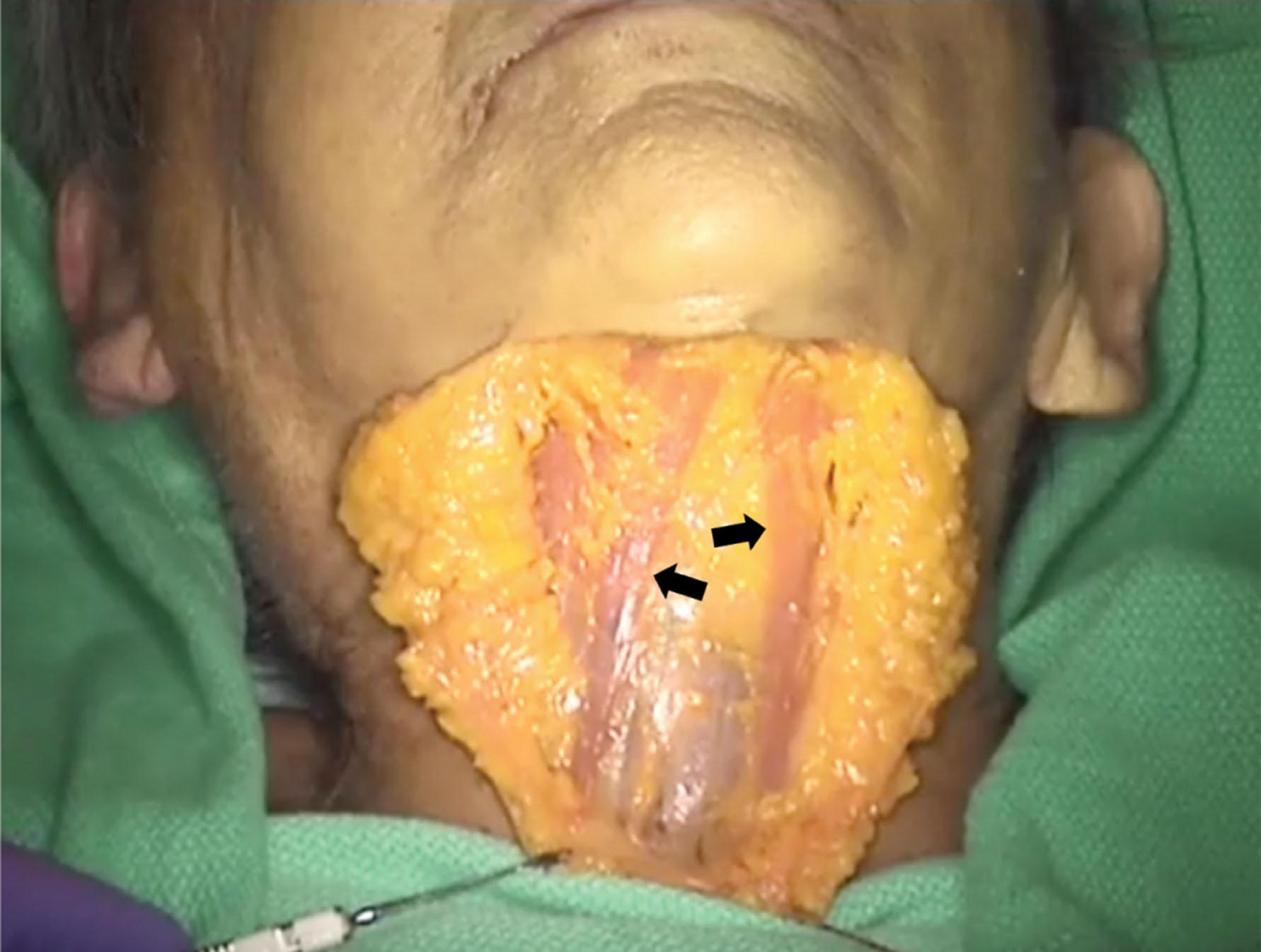
In the lower face, the marginal mandibular nerve exits from under the anterior–inferior portion of the parotid gland. In this location, the course is deep to the parotid-masseteric fascia. It runs horizontally along the lower border of the mandible passing from deep to the parotid-masseteric fascia into the subSMAS (SMAS = superficial musculo-aponeurotic system) cleavage plane at the level of the facial vessels and continues superficial to the facial vessels to innervate the depressor anguli oris and mentalis muscles. Anteriorly at this transition point over the facial artery and vein, the marginal mandibular branch is most prone to injury during facelift surgery. Recovery after complete transection is unlikely since it most often exists as a single branch with infrequent cross-innervation from buccal branches of the facial nerve. Dingman and Grabb demonstrated in their landmark study that the marginal mandibular nerve traveled at or above the lower jaw border in 81% of cadaver specimens posterior to the facial vessels and was found above the lower jaw border in 100% of specimens anterior to the facial vessels. Although the exact course of the marginal mandibular nerve in relation to the mandibular border remains an area of controversy, what is not controversial is its relative location superficial to deep ( Fig. 9.10.2 ). Huettner also demonstrated in a cadaveric study that the mandibular cutaneous ligament is located in the parasymphyseal region 67.8 ± 3.3 mm from the horizontal line constructed from the gonial angle along the inferior border of the mandible ( Fig. 9.10.3 ). The marginal mandibular nerve passes 9.7 ± 1.2 mm superior to the mandibular ligament in the subSMAS plane. Injury to the nerve can therefore only occur by platysma violation or through conduction injury from electrocautery. Both the lingual and hypoglossal nerves lie deep to the submandibular gland. Therefore, intracapsular resection of the gland minimizes the risk of both bleeding and nerve injury.
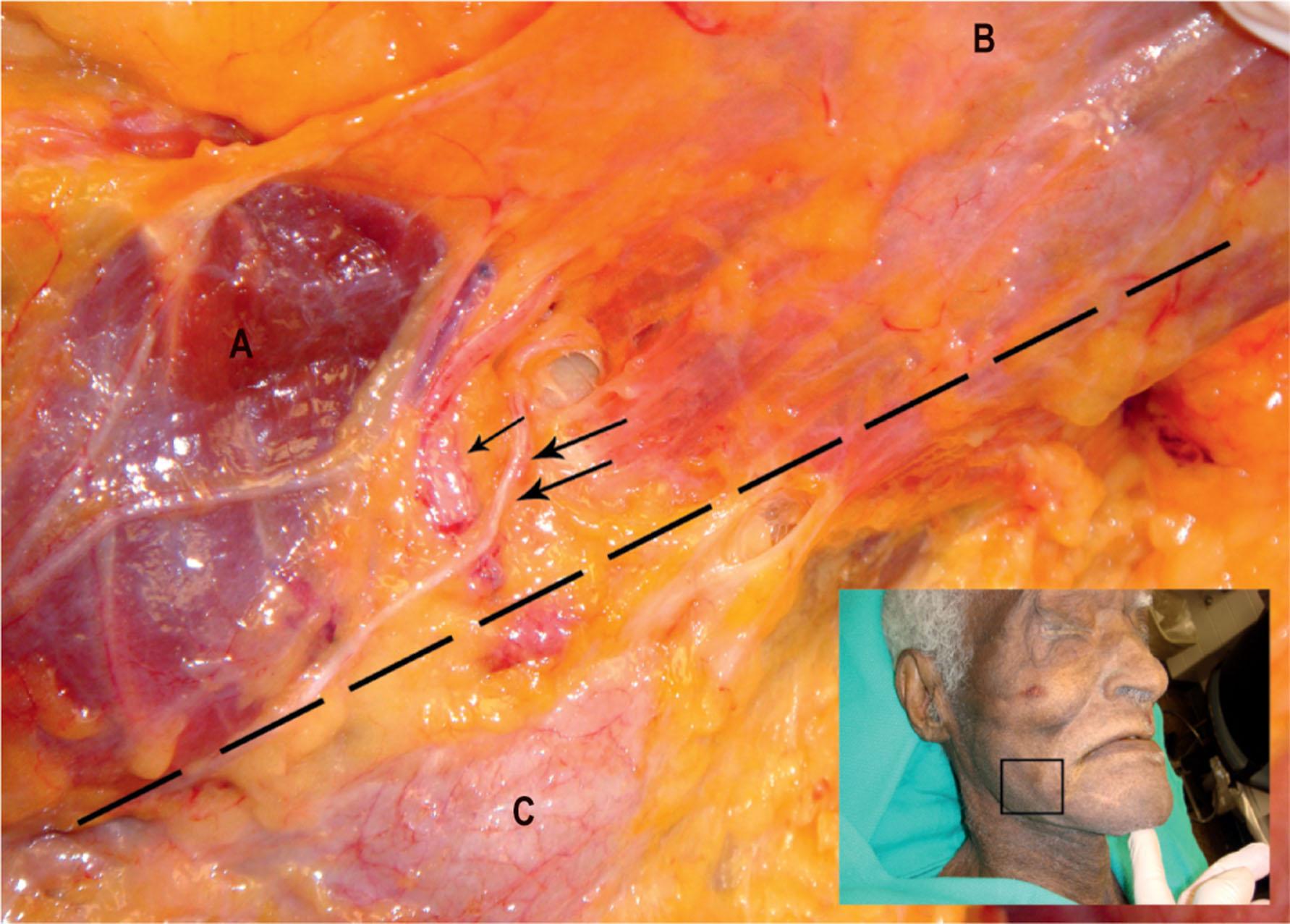
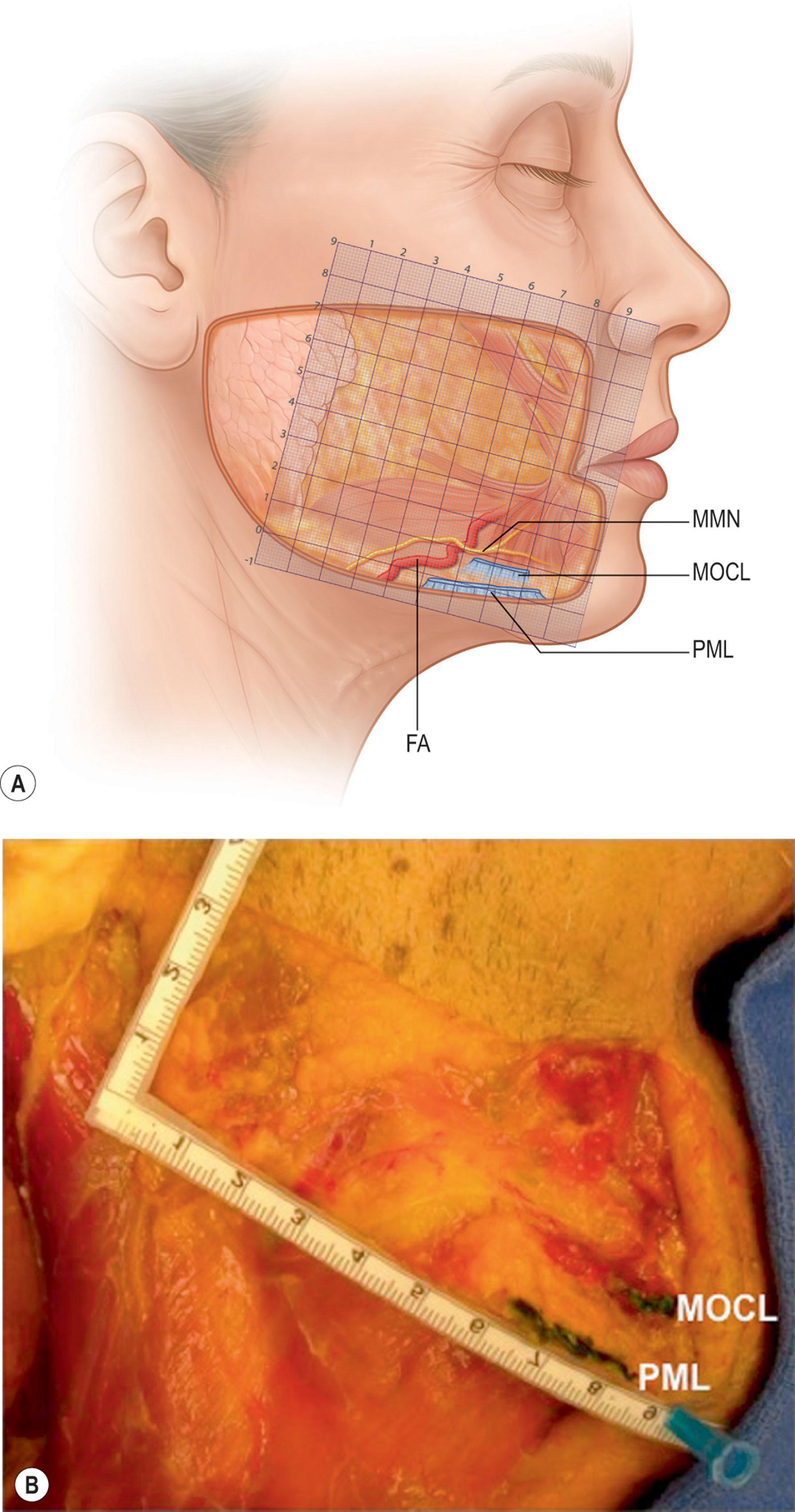
The cervical branch of the facial nerve supplies innervation to the platysma muscle, acting to depress the lateral commissure. It exits the parotid gland within 1.5 cm of the gonial angle deep to the deep parotid-masseteric fascia and then quickly transitions to the subplatysmal plane. Cadaveric studies suggest that a single cervical branch root is present proximal to the facial vessels. The nerve then divides into multiple rami anteriorly from 1.75 cm to 4.5 cm caudal to the lower mandibular border. Sinno and Thorne have shown persistent continuity of this cervical branch trunk following simulated platysmaplasty techniques, demonstrating that innervation to the platysma remains intact after surgical intervention.
Although not a motor nerve, the most commonly injured nerve in facelift/necklift surgery is the great auricular nerve (GAN). The GAN is a purely sensory nerve that supplies the earlobe, antitragus, scapha, helical crus, and lower posterior auricle. Historically, the most common method for locating the GAN, where it is most superficial and vulnerable to injury, is at McKinney's point, defined as a point 6.5 cm inferior to the external auditory canal as it crosses the midbelly of the sternocleidomastoid muscle. Since that time, other authors have found greater variation in the location of the GAN than initially reported. In a cadaveric study, Ozturk et al . described a danger zone of injury for the GAN, which can be defined by drawing a vertical line through the midlobule perpendicular to the Frankfort's horizontal, followed by a 30° angle constructed posteriorly from the midlobule. Ozturk et al . found that the superior course of the GAN fell within this triangle 100% of the time ( Fig. 9.10.4 , ![]() ). Remaining in a superficial dissection plane over this danger zone above the cervical fascia can greatly decrease incidence of GAN injury.
). Remaining in a superficial dissection plane over this danger zone above the cervical fascia can greatly decrease incidence of GAN injury.
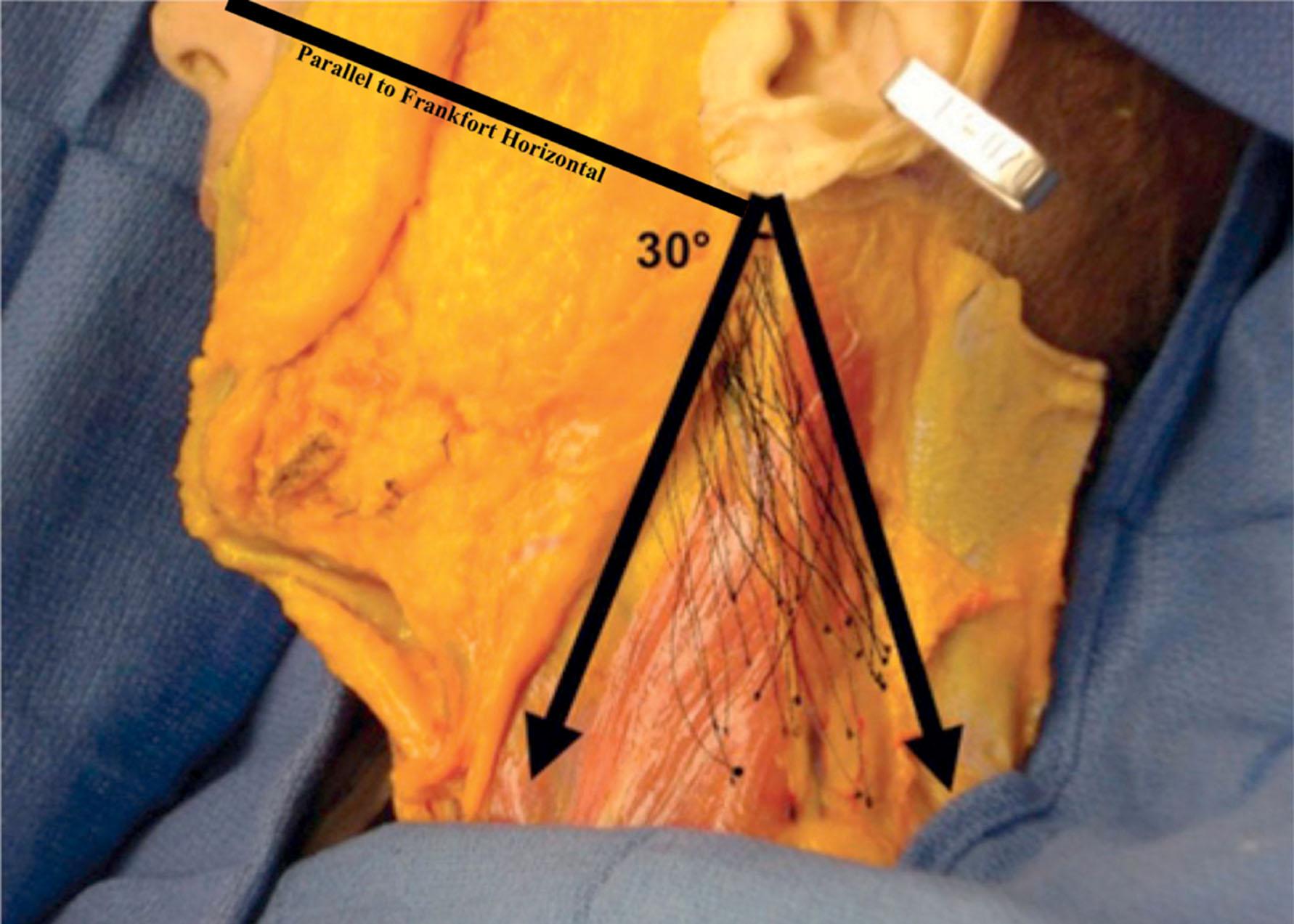
Three important planes exist in the neck: the superficial plane between the skin and the platysma; the intermediate plane deep to the platysma containing the subplatysmal fat, the anterior belly of the digastric muscles, and the submandibular glands; and the deep plane deep to the deep fascia.
Several authors have described the fat compartments in the neck and detailed the anatomy of subplatysmal fat. Rohrich et al . described central, medial, and lateral compartments which form a V-shaped adipose tissue mass that extends from the lateral third of the mandible to the thyroid cartilage. In contrast, Larson et al . only identified central and lateral compartments. They found that the supraplatysmal fat represented 44% of the total neck fat, subplatysmal fat contributed to 30.7%, and the submandibular glands 24.5% of neck volume. The contribution from fat deep to the deep fascia was <1%. Orra et al . have demonstrated through volumetric computed tomography that supraplatysmal fat volume is greater than subplatysmal fat volume in all patients regardless of age. Furthermore, total supraplatysmal fat volume decreases with age and becomes less uniformly distributed, contributing to the development of a more obtuse cervicomandibular angle in the elderly.
The platysma muscles are thin, bilateral structures that are continuous with the SMAS in the face. The platysma is vertically oriented in the neck, extending from the clavicles inferiorly and predominantly horizontal in the lower face. While separate structures, the platysma is intimately related to the mandibular septum, as both send fibers to the mandibular border. Reece et al . have described the mandibular septum. They suggest that the septum may act as a sling impeding fat descent below the mandible, thus contributing to jowl formation. As the platysma is continuous with the SMAS and has minimal bone contact, laxity in the SMAS is transmitted to the neck. Therefore, maneuvers performed during facelift surgery that tighten and reposition the SMAS also tighten the platysma and have an effect on both the jawline and cervicomental angle. There are three variations of platysmal anatomy in the submental region as described by de Castro ( Fig. 9.10.5 ).
Type I (75%): interdigitation of the platysmal muscles 1–2 cm posterior to the mandibular symphysis.
Type II (15%): interdigitation of the platysma muscles from the mandibular symphysis to the thyroid cartilage.
Type III (10%): no interdigitation of the platysma muscles.
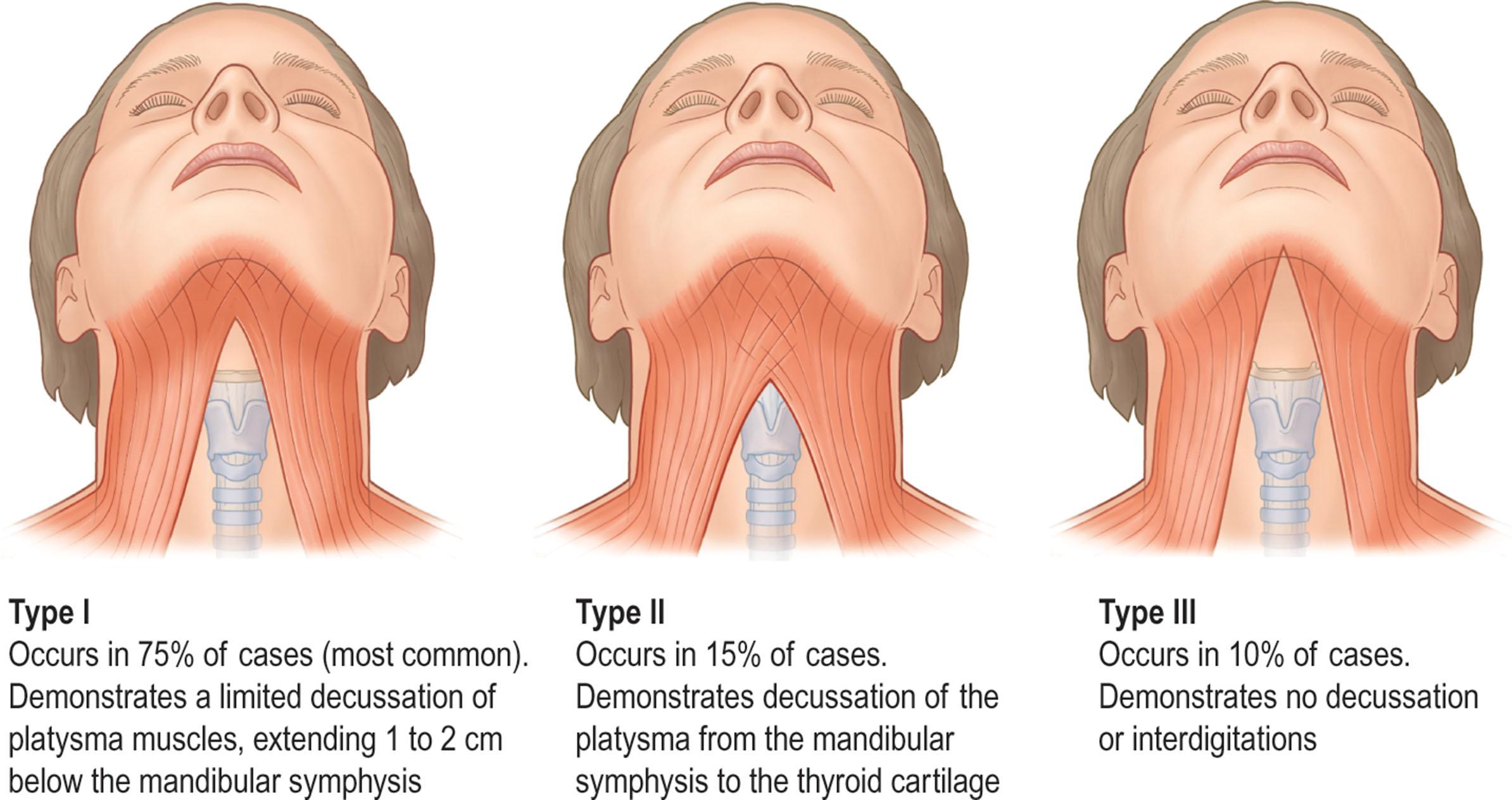
The retaining ligaments from the free medial edges of the platysma muscle to the deep cervical fascia attenuate with age. As a result, these platysmal edges pull away from the underlying structures, shorten, and form visible bands.
In addition to changes in skin quality, soft-tissue laxity, fat maldistribution, and developmental variations of the bony anatomy, all have a decided effect on the aging process. Specifically, sagittal and vertical microgenia and/or a skeletal class II appearance will negatively impact soft-tissue support of the lower face and neck. Similarly, an obtuse gonial angle or mandibular plane will negatively affect lower facial aging. Conversely, correction of these skeletal deformities will have a positive effect on the facial aging process ( Fig. 9.10.6 ). However, even if these bony deficiencies are not addressed directly with osseus genioplasty or placement of a chin implant, surgical face and necklift can still have a dramatic effect on chin ptosis with improved aesthetics ( Fig. 9.10.7 )
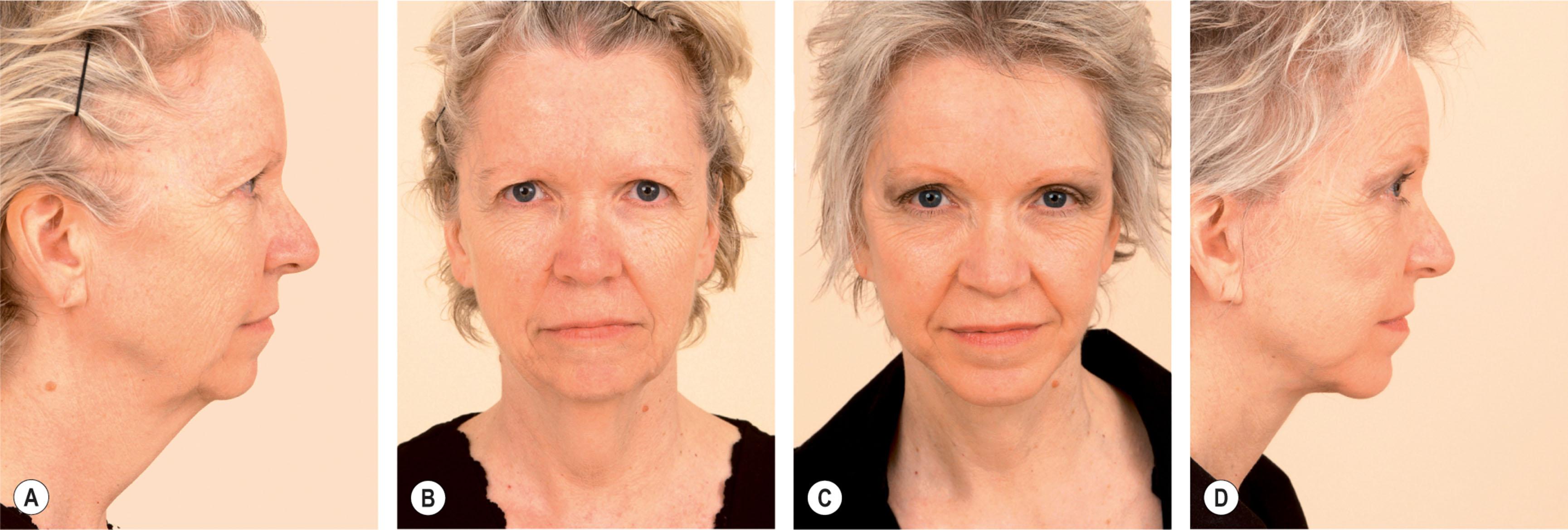

The hallmark of a youthful face is a well-contoured neck. Ellenbogen described the criteria of favorable neck aesthetics, including a curving or blunt cervicomental angle of 105–120 degrees, a distinct inferior mandibular border, a slightly visible thyroid cartilage, and a visible anterior sternocleidomastoid border ( Fig. 9.10.8 ). Knize graded the degree of neck deformity on a scale from I–IV. Grade I represents an ideal neck angle, while increasing numbers indicate worsening deformity in blunting of that angle. Using this non-validated system, he documented consistent and significant long-term neck correction following anterior lipectomy and platysmaplasty. The anterior-only approach to the neck is essentially an extension of the submental liposuction technique. Knize is careful to note that changes following this procedure are seen predominantly in the profile view.
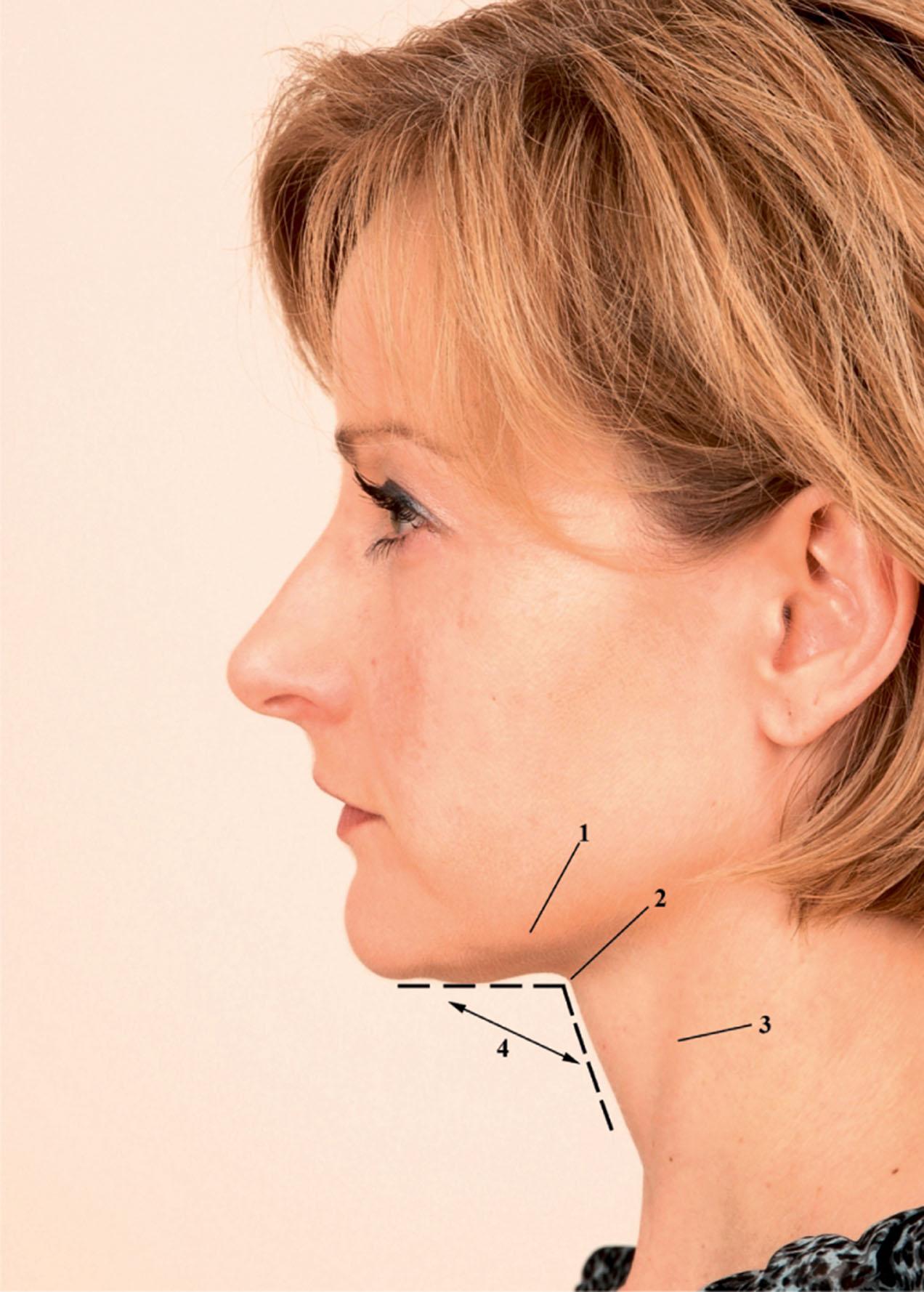
1966: Pitanguy – anatomical description of the facial nerve.
1978: Connell – contouring the neck by lipectomy and a muscle sling.
1979: Aston – the platysma muscle in rhytidoplasty.
1980: de Castro – the anatomy of the platysma muscle.
1980: Ellenbogen and Karlin – visual criteria for restoring the youthful neck.
1985: Courtiss – suction lipectomy of the neck.
1989: Furnas – the retaining ligaments of the cheek.
1989: Stuzin – anatomy of the frontal branch of the facial nerve.
1990: Feldman – corset platysmaplasty.
1991: De Pina and Quinta – aesthetic resection of the submandibular gland.
1992: Hamra – deep plane rhytidectomy.
1992: Stuzin – the relationship of the superficial and deep facial fascias.
1995: Giampapa and Di Bernardo – neck recontouring with suture suspension and liposuction.
1996: Biggs – excision of neck redundancy with single Z-plasty closure.
1998: Knize – limited incision submental lipectomy and platysmaplasty.
1997: Connell and Shamoun – the significance of digastric muscle contouring.
1997: Baker – short scar facelift .
2002: Tonnard – minimal access cranial suspension (MACS) lift.
2005: Zins and Fardo – the anterior-only approach to neck rejuvenation.
2006: Sullivan et al . – neck contouring with submandibular gland suspension.
2008: Mendelson et al . – surgical anatomy of the lower face: the premasseter space, the jowl, and the labiomandibular fold.
2011: Martén et al . – the safety of facelift in the elderly.
2013: Alghoul et al. – relationship of the zygomatic facial nerve to the retaining ligaments of the face.
2014: Feldman – necklift my way: an update.
2015: Food and Drug Administration (FDA) approves the use of deoxycholic acid for treatment of supraplatysmal submental adiposity.
2017: Pelle-Ceravolo – lateral skin-platysma displacement neck lift.
2019: Sinno and Thorne – cervical branch of the facial nerve following various platysmaplasty maneuvers.
2021: Kochuba et al . – effect of tranexamic acid in facelift hemostasis.
A global approach to facial aging is the most effective means of improving aesthetics, as the neck and face are ideally treated simultaneously. Therefore, a necklift is an important component of virtually any facelift procedure. Similarly, it is rare for a patient to be best treated with an isolated neck procedure only. While this chapter is devoted to the aging neck, the maneuvers described should be considered as part of the facelift. Essentially all techniques used for neck correction can be performed through the submental incision except for skin resection.
Aging in the lower face is due to varying degrees of volume loss and laxity that develop in the skin, retinaculum cutis, and cutaneous ligaments of the face. The predominant component most responsible for facial aging dictates the most appropriate type of face/necklift procedure. Laxity in the lower masseteric-cutaneous ligaments plays a major factor in the development of jowling. More recently, this anatomy and its implications for aging have been further clarified by Mendelson and is thoroughly reviewed in Chapter 9.2 . Mendelson's “premasseteric space” overlies the lower half of the masseter muscle. The roof of the space is the platysma, the posterior border is represented by the posterior border of the masseter muscle, the inferior border of the mandible and mandibular septum represent its inferior border, the anterior border is delineated by the lower masseteric-cutaneous ligaments and the anterior border of the masseter. Superiorly are the stout upper masseteric-cutaneous ligaments. This is a potential space in youth but becomes a true space with facial aging, expanding and bulging over the masseteric ligaments. This results in stretching and jowl formation.
In Chapters 9.3 – 9.8 , 9.11 , 9.12 facelift techniques are reviewed, and authors present their preferred method to manipulate the deeper soft tissues of the face. While aesthetic surgeons have popularized various approaches in the plastic surgery literature, superiority of subSMAS procedures compared to SMAS plication and SMASectomy techniques remains open for debate. Variation in the vector of SMAS repositioning also exists between techniques, as some rely on vertical advancement of the SMAS, while others utilize a superior-oblique vector. Despite these variations, it remains clear that all facelift procedures have translational effects on the neck that improve its contour and define the jawline. Laxity in the lower face is transmitted to the neck because the SMAS and the platysma are located in the same plane with minimal bony attachments. Therefore, tightening of the SMAS has a decided effect on the platysma. Conceptually, SMAS plication and subSMAS maneuvers are all based on the principle that a major component of facial aging is laxity in the SMAS complex. Therefore, the tightened SMAS acts as the vehicle for repositioning facial and neck fat back into the face ( ![]() ). In sequencing SMAS manipulation and platysmaplasty, SMAS procedures should be performed first. Although somewhat controversial, if the platysmaplasty is done first, this locks the platysma in place, preventing the repositioning of jowl and neck fat back into the face by SMAS elevation. By first tightening the SMAS, the effect is translated over the jawline and begins to define the cervicomental angle. Then, midline tightening of the platysma merely takes up the excess laxity in the horizontal plane, further defining the neckline.
). In sequencing SMAS manipulation and platysmaplasty, SMAS procedures should be performed first. Although somewhat controversial, if the platysmaplasty is done first, this locks the platysma in place, preventing the repositioning of jowl and neck fat back into the face by SMAS elevation. By first tightening the SMAS, the effect is translated over the jawline and begins to define the cervicomental angle. Then, midline tightening of the platysma merely takes up the excess laxity in the horizontal plane, further defining the neckline.
In Chapter 9.4 , the MACS lift principle, originally described by Tonnard et al ., is reviewed. In this technique, platysma tightening is accomplished along a vertical vector utilizing purse-string sutures in the cheek. Borrowing on concepts proposed by Fogli, Tonnard et al . rely on posterior-superior traction on the neck rather than anterior (medial). They believe that it is counterproductive to separate skin from platysma and address the platysma with a vertically oblique vector anchored to Lore's fascia (platysma auricular fascia, or parotid cutaneous ligaments). Higher in the cheek, oblique vectors are utilized, suturing submalar fat to the malar bone and placing a running suture ending at the anterior parotid fascia.
Become a Clinical Tree membership for Full access and enjoy Unlimited articles
If you are a member. Log in here